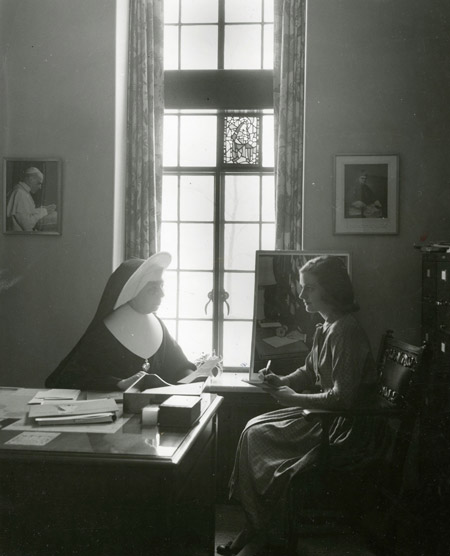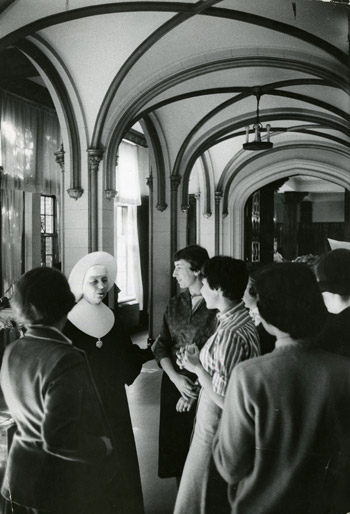
In 1957, Life magazine ran a profile of Sister Mary Madeleva Wolff, CSC, then president of Saint Mary’s College in Notre Dame, Indiana. The profile describes Sr. Madeleva as one of the best living Catholic poets and “a nun with no nonsense about her” and focuses on her success: in the first dozen years of her presidency, she had overseen a dramatic increase in enrollment, from 250 to 1,000 students.
A graduate of Saint Mary’s, Sister Madeleva joined the Sisters of the Holy Cross as a student and went on to earn a Ph.D. in English at the University of California, Berkeley, in 1925. At Saint Mary’s, she was known as an innovative leader who embraced a traditional curriculum while engaging in modern administrative practices.
The Life profile notes what would become one of Sister Madeleva’s most significant legacies: founding the first Catholic theological school for laypeople. “Theology classes were the least popular,” she told Life. “One day, I was watching a biology class and the students spent three hours over an embalmed cat. That was because they had a good teacher. The teacher sold that cat. I decided we needed teachers who could sell God.”
By 1957, the article explained, the college “offer[ed] bachelor’s, master’s and doctoral degrees in theology, which Sister Madeleva calls ‘the best science.’”

In her 1997 book Madeleva: A Biography, Gail Porter Mandell explained that as an educator and a Catholic religious worker, Sister Madeleva had long been “acutely aware of the deplorable state of theological education in most Catholic schools.” Often, she said, priests – the only trained Catholic theologians – were not available to teach, and theology courses “were entrusted to well-intentioned sisters” with no formal training. Sister Madeleva contacted a handful of Catholic graduate schools of theology to ask if they would enroll sisters and other laypeople. They would not.
Soon after, she discussed the situation with an old friend, Bishop Edwin O’Hara of Kansas City. He suggested she start a graduate theology program. Sister Madeleva found a handful of priests willing to teach in the program, which opened in 1943. The next year, the School of Sacred Theology at Saint Mary’s received papal approval.
Ultimately, the school granted 76 doctoral and 354 master’s degrees to both religious and lay graduates. By 1970, the last year Saint Mary’s awarded graduate degrees in theology, other Catholic graduate programs had opened up to laypeople — ensuring that Sister Madeleva’s determined vision could and would endure.
Verbatim
How much do you preach from the Old Testament? How comfortable are you delving into that ancient family history to unearth the words of God for us today? As we head further into the climate crisis – this growing wilderness, the expanse of which we cannot anticipate – we’re going to need to refamiliarize ourselves with the laments that are so plentiful in the Old Testament, with the prayers of repentance, and with the pleas for mercy and forgiveness, especially as the window of today closes in on us.”
—Tom Yoder Neufeld,
Professor emeritus at Conrad Grebel University College, Ontario, from a Feb. 24 address at Anabaptist Mennonite Biblical Seminary in Elkhart, Indiana, during a joint conference of AMBS and Mennonite Church USA.